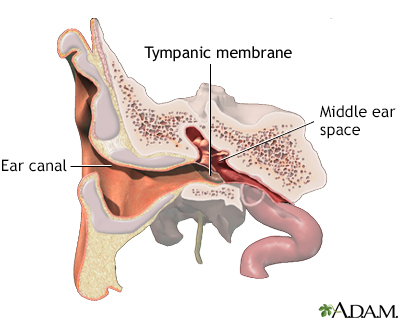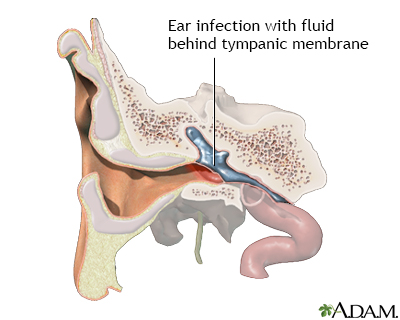Ear infection - chronic
Chronic ear infection is fluid, swelling, or an infection behind the eardrum that does not go away or keeps coming back. It may cause long-term or permanent damage to the ear and involves a hole in the eardrum (perforation) that does not heal.

Middle ear infection (otitis media)
Otitis media is an inflammation or infection of the middle ear. Acute otitis media (acute ear infection) occurs when there is bacterial or viral infection of the fluid of the middle ear, which causes production of fluid or pus. Chronic otitis media occurs when the eustachian tube becomes blocked repeatedly due to allergies, multiple infections, ear trauma, or swelling of the adenoids.
Causes
The eustachian tube runs from the middle of each ear to the back of the throat. This tube drains fluid made in the middle ear. If the eustachian tube becomes blocked, fluid can build up. When this happens, infection can occur. A chronic ear infection develops when fluid or an infection behind the eardrum does not go away.

Middle ear infection
A middle ear infection is also known as otitis media. It is one of the most common of childhood infections. With this illness, the middle ear becomes red, swollen, and inflamed because of bacteria trapped in the eustachian tube.
A chronic ear infection may be caused by:
- An acute ear infection that does not completely go away
Acute ear infection
Suspected ear infections are one of the most common reasons parents take their children to their health care provider. The most common type of ear i...
 ImageRead Article Now Book Mark Article
ImageRead Article Now Book Mark Article - Repeated ear infections

Eustachian tube
Ear infections are more common in children because their eustachian tubes are shorter, narrower, and more horizontal than in adults, making the movement of air and fluid difficult. Bacteria can become trapped when the tissue of the eustachian tube becomes swollen from colds or allergies. Bacteria trapped in the eustachian tube may produce an ear infection that pushes on the eardrum causing it to become red, swollen, and sore.
Suppurative chronic otitis is a term used to describe an eardrum that keeps rupturing, draining, or swelling in the middle ear or mastoid area (the bone behind the ear) and does not go away.
Ear infections are more common in children because their eustachian tubes are shorter, narrower, and more horizontal than in adults. Chronic ear infections are much less common than acute ear infections.
Symptoms
Symptoms of a chronic ear infection may be less severe than symptoms of an acute infection. The problem may go unnoticed and untreated for a long time.
Symptoms may include:
- Ear pain or discomfort that is usually mild and feels like pressure in the ear
- Fever, usually low-grade
- Fussiness in infants
- Pus-like drainage from the ear
Drainage from the ear
Ear discharge is drainage of blood, ear wax, pus, or fluid from the ear.
 ImageRead Article Now Book Mark Article
ImageRead Article Now Book Mark Article - Hearing loss
Hearing loss
Hearing loss is being partly or totally unable to hear sound in one or both ears.
 ImageRead Article Now Book Mark Article
ImageRead Article Now Book Mark Article
Symptoms may continue or come and go. They may occur in one or both ears.
Exams and Tests
Your health care provider will look in the ears using an otoscope. The exam may reveal:
- Dullness, redness in the middle ear
- Air bubbles in the middle ear
- Thick fluid in the middle ear
- Eardrum that sticks to the bones in the middle ear
- Draining fluid from the eardrum
- A hole in the eardrum
- An eardrum that bulges out or pulls back inward (collapses)
Tests may include:
- Cultures of the ear fluid that may show a bacterial infection.
- A CT scan of the head or mastoids may show that the infection has spread beyond the middle ear.
CT scan of the head
A head computed tomography (CT) scan uses many x-rays to create pictures of the head, including the skull, brain, eye sockets, and sinuses.
 ImageRead Article Now Book Mark Article
ImageRead Article Now Book Mark Article - Hearing tests may be needed.
Treatment
Your provider may prescribe antibiotics if the infection is caused by bacteria. These medicines may need to be taken for a long time. They may be given by mouth or into a vein (intravenously).
Intravenously
Intravenous means "within a vein. " Most often it refers to giving medicines or fluids through a needle or tube inserted into a vein. This allows th...
Read Article Now Book Mark ArticleIf there is a hole in the eardrum, antibiotic ear drops are used. The provider may recommend using a mild acidic solution (such as vinegar and water) for a hard-to-treat infected ear that has a hole. A surgeon may need to clean out (debride) tissue that has gathered inside the ear.
Other surgeries that may be needed include:
- Surgery to clean the infection out of the mastoid bone (mastoidectomy)
Mastoidectomy
A mastoidectomy is surgery to remove cells in the hollow, air-filled spaces in the skull behind the ear within the mastoid bone. These spaces are ca...
 ImageRead Article Now Book Mark Article
ImageRead Article Now Book Mark Article - Surgery to repair or replace the small bones in the middle ear
- Repair of the eardrum
- Ear tube surgery (myringotomy)
Ear tube surgery
Ear tube insertion involves placing tubes through the eardrums. The eardrum is the thin layer of tissue that separates the outer and middle ear. No...
 ImageRead Article Now Book Mark Article
ImageRead Article Now Book Mark Article
Outlook (Prognosis)
Chronic ear infections often respond to treatment. However, your child may need to keep taking medicines for several months.
Chronic ear infections are not life threatening. However, they can be uncomfortable and may result in hearing loss and other serious complications.
Possible Complications
A chronic ear infection may cause permanent changes to the ear and nearby bones, including:
- Infection of the mastoid bone behind the ear (mastoiditis)
Mastoiditis
Mastoiditis is an infection of the mastoid bone of the skull. The mastoid bone is located just behind the ear.
 ImageRead Article Now Book Mark Article
ImageRead Article Now Book Mark Article - Ongoing drainage from a hole in the eardrum that does not heal, or after ear tubes are inserted
- Cyst in the middle ear (cholesteatoma)
Cholesteatoma
Cholesteatoma is a type of skin cyst that is located in the middle ear and mastoid bone in the skull.
 ImageRead Article Now Book Mark Article
ImageRead Article Now Book Mark Article - Hardening of the tissue in the middle ear (tympanosclerosis)
- Damage to, or wearing away of the bones of the middle ear, which help with hearing
- Paralysis of the face
Paralysis of the face
Facial paralysis means that a person is no longer able to move some or all of the muscles on one or both sides of the face.
 ImageRead Article Now Book Mark Article
ImageRead Article Now Book Mark Article - Inflammation around the brain (epidural abscess) or in the brain
Epidural abscess
An epidural abscess is a collection of pus (infected material) and germs between the outer covering of the brain and spinal cord and the bones of the...
 ImageRead Article Now Book Mark Article
ImageRead Article Now Book Mark Article - Damage to the part of the ear that helps with balance
Hearing loss from damage to the middle ear may slow language and speech development. This is more likely if both ears are affected.
Permanent hearing loss is rare, but the risk increases with the number and length of infections.
When to Contact a Medical Professional
Contact your provider if:
- You or your child has signs of a chronic ear infection
- An ear infection does not respond to treatment
- New symptoms develop during or after treatment
Prevention
Getting prompt treatment for an acute ear infection may reduce the risk of developing a chronic ear infection. Have a follow-up exam with your provider after an ear infection has been treated to make sure that it is completely cured.
Reviewed By
Charles I. Schwartz, MD, FAAP, Clinical Assistant Professor of Pediatrics, Perelman School of Medicine at the University of Pennsylvania, General Pediatrician at PennCare for Kids, Phoenixville, PA. Also reviewed by David C. Dugdale, MD, Medical Director, Brenda Conaway, Editorial Director, and the A.D.A.M. Editorial team.
Chole RA, Sharon JD. Chronic otitis media, mastoiditis, and petrositis. In: Flint PW, Francis HW, Haughey BH, et al, eds. Cummings Otolaryngology: Head and Neck Surgery. 7th ed. Philadelphia, PA: Elsevier; 2021:chap 140.
Pelton SI. Otitis externa, otitis media, and mastoiditis. In: Bennett JE, Dolin R, Blaser MJ, eds. Mandell, Douglas, and Bennett's Principles and Practice of Infectious Diseases. 9th ed. Philadelphia, PA: Elsevier; 2020:chap 61.
Player B. Otitis media. In: Kliegman RM, St. Geme JW, Blum NJ, et al, eds. Nelson Textbook of Pediatrics. 22nd ed. Philadelphia, PA: Elsevier; 2025:chap 680.
Rosenfeld RM, Tunkel DE, Schwartz SR, et al. Clinical Practice Guideline: Tympanostomy tubes in children (update). Otolaryngol Head Neck Surg. 2022;166(1_suppl):S1-S55. PMID: 35138954 pubmed.ncbi.nlm.nih.gov/35138954/.








